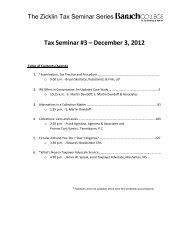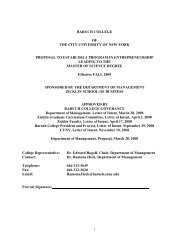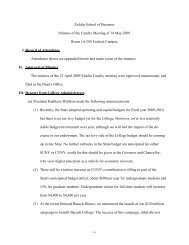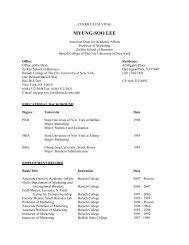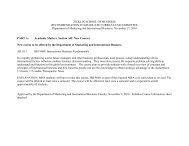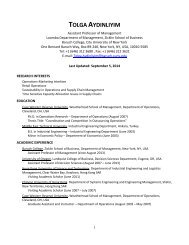Current Financial Reporting Trends
Current Financial Reporting Trends: - Zicklin School of Business
Current Financial Reporting Trends: - Zicklin School of Business
- No tags were found...
Create successful ePaper yourself
Turn your PDF publications into a flip-book with our unique Google optimized e-Paper software.
information disclosed in your fiscal 2003 Form 10-K. We are particularly interested in how it was<br />
presented in the schedule of changes in goodwill, Footnote 3, page 49 of the financial statements<br />
included in your Form 10-K for fiscal 2003. Please advise supplementally and in detail.<br />
Comment #633 – Form 10-K; SIC: 4841 Cable & Other Pay Television Services<br />
We note your discussion of your acquisition of [x] in markets served under your joint operating<br />
agreement. Tell us more about the terms of the acquisition, the preexisting joint operating<br />
agreement and how you applied the guidance in SFAS 141 and the consensus in EITF 04-1 in<br />
accounting for this transaction under the purchase method of accounting with gain recognition of<br />
$15.6 million. Disclose the nature of the preexisting relationship and the measurement of the<br />
amount of the settlement and the valuation used to determine the settlement amount as required<br />
by paragraph 8 of EITF 04-1.<br />
Comment #301 – Form 10-K; SIC: 6022 State Commercial Banks<br />
In addition to the annual testing of goodwill for impairments required by paragraph 26 of SFAS 142,<br />
please tell us and disclose in future filings the circumstances in which goodwill may be tested for<br />
impairment between annual tests as stated in paragraph 28 of SFAS 142.<br />
Comment #7 – Form 10-K; SIC: 7389 Services-Business Services, NEC<br />
Please tell us how you considered all of the factors in paragraph 11 of SFAS 142 in determining<br />
that your [x] trademark intangible asset has an indefinite life. In this regard please also describe<br />
any legal, regulatory, contractual, competitive, economic or other factors associated with this<br />
intangible asset and how you considered whether any of these factors limit the useful life of the<br />
intangible asset. Finally, please tell us how you determined the fair value including the assumptions<br />
and methodology used supporting the value assigned to this intangible asset.<br />
In the response to the previous comment, the registrant reviewed the company’s strategy<br />
with regard to the strategy as it relates to the trademark. The response then went on to<br />
how the components of paragraph 11 of SFAS 142 applied to their specific example.<br />
Response to Comment #7 – Form 10-K; SIC: 7389 Services-Business Services, NEC<br />
We utilized paragraph 11 of SFAS 142 in our assessment process in determining that the [x]<br />
trademark intangible asset has an indefinite life, and the following is a summary of that analysis:<br />
a. The expected use of the asset by the entity – We intend to continue to leverage our trademark<br />
in connection with providing our consumer-to-consumer money transfer services in order to<br />
continue growing our customer base and resulting revenue. As discussed above, we believe we<br />
can continue to generate future cash flows using the [x] trademark indefinitely.<br />
b. The expected useful life of another asset or a group of assets to which the useful life of the<br />
intangible asset may relate – There are no other assets or groups of assets upon which our<br />
trademark is dependent.<br />
c. Any legal, regulatory, or contractual provisions that may limit the useful life – The trademark is<br />
governed by United States federal law, which allows indefinite re-registration of trademarks. We<br />
are not aware of any regulatory or contractual provisions that would prevent such re-registration, or<br />
any other factors that may limit the useful life of the trademark. We intend to re-register the<br />
trademark indefinitely.<br />
d. Any legal, regulatory, or contractual provisions that enable renewal or extension of the asset’s<br />
legal or contractual life without substantial cost – As discussed above, the trademark is governed<br />
by United States federal law, which allows an indefinite number of 10-year renewals of trademark<br />
registration. We believe the cost of re-registration of the trademark is insignificant to the Company.<br />
According to the United States Patent and Trademark Office 2006 Fee Schedule, the cost of reregistration<br />
of a trademark is $400, and we do not believe attorney’s or other fees that might be<br />
incurred by the Company in connection with this re-registration will be substantial relative to the<br />
future cash flows we anticipate the [x]-branded service will generate.<br />
e. The effects of obsolescence, demand, competition, and other economic factors – We believe<br />
the consumer-to-consumer money transfer services provided under the trademark will continue to<br />
18



